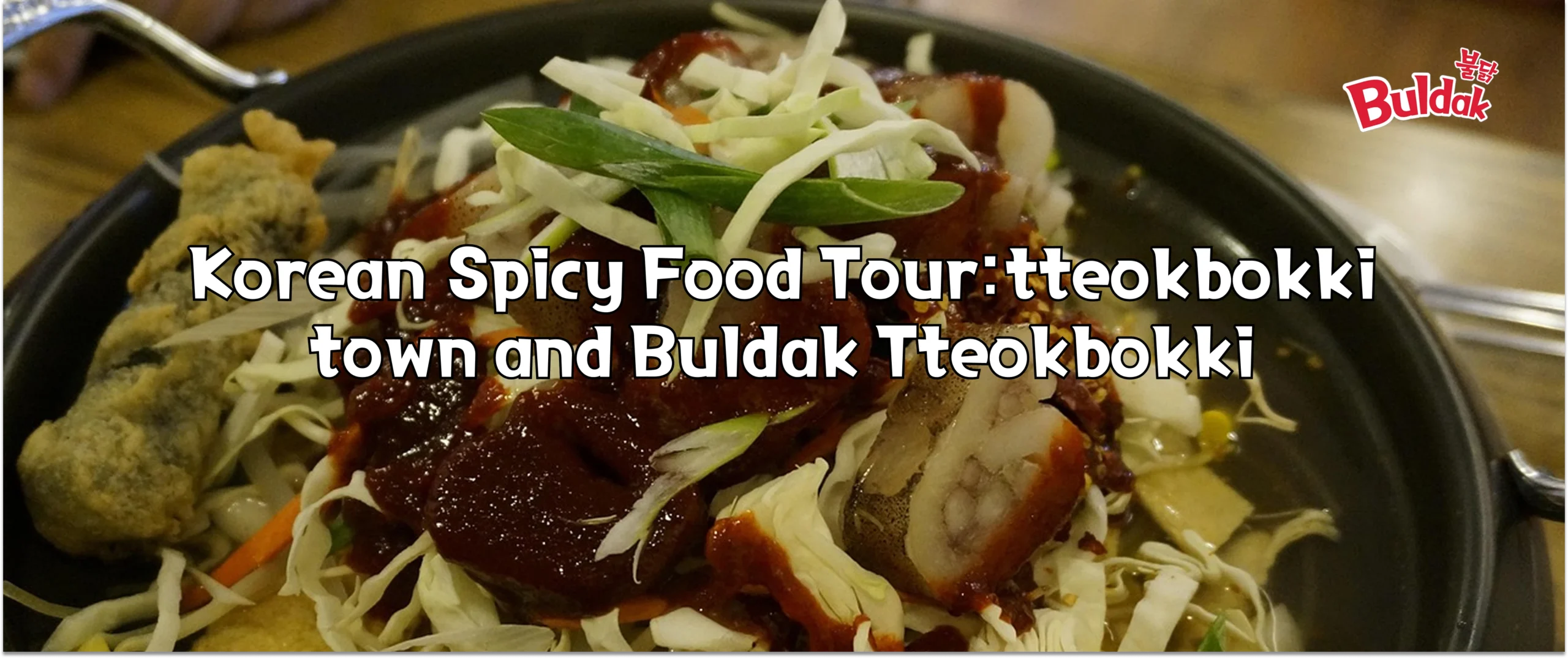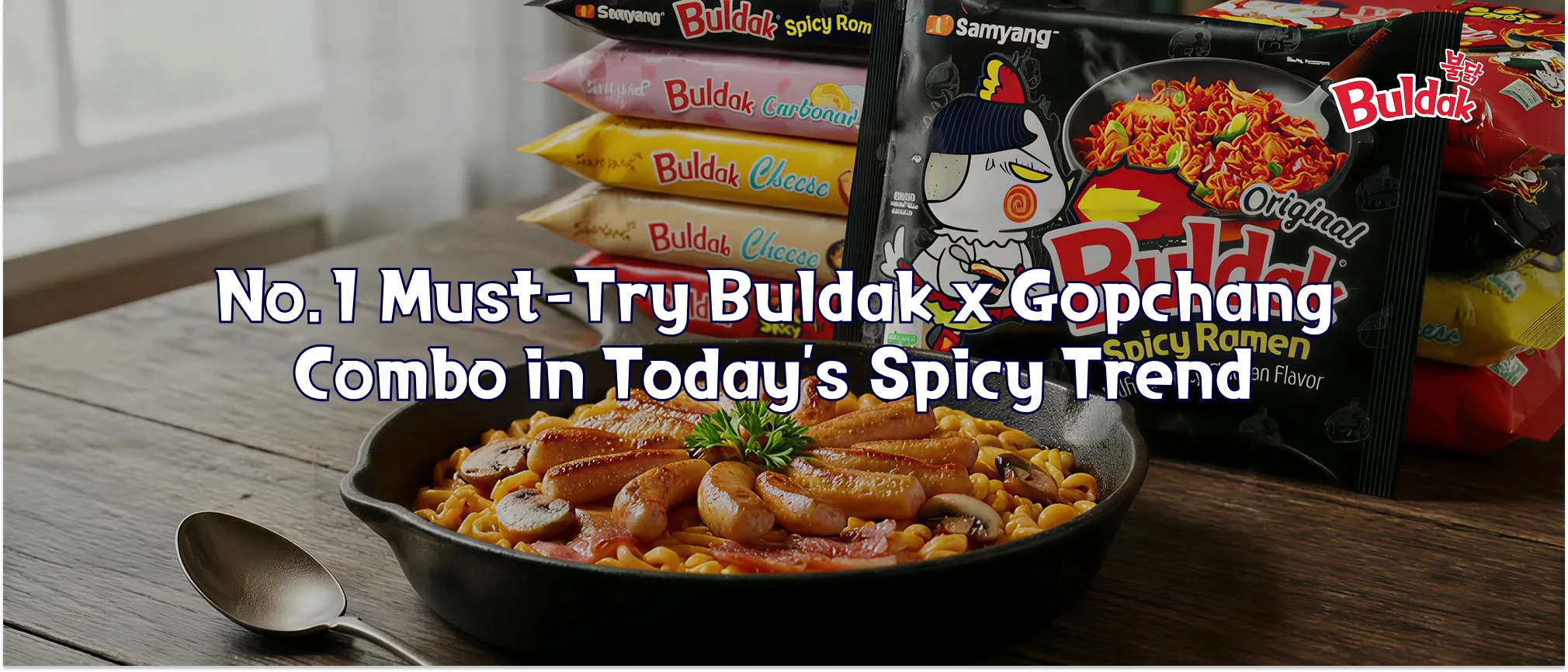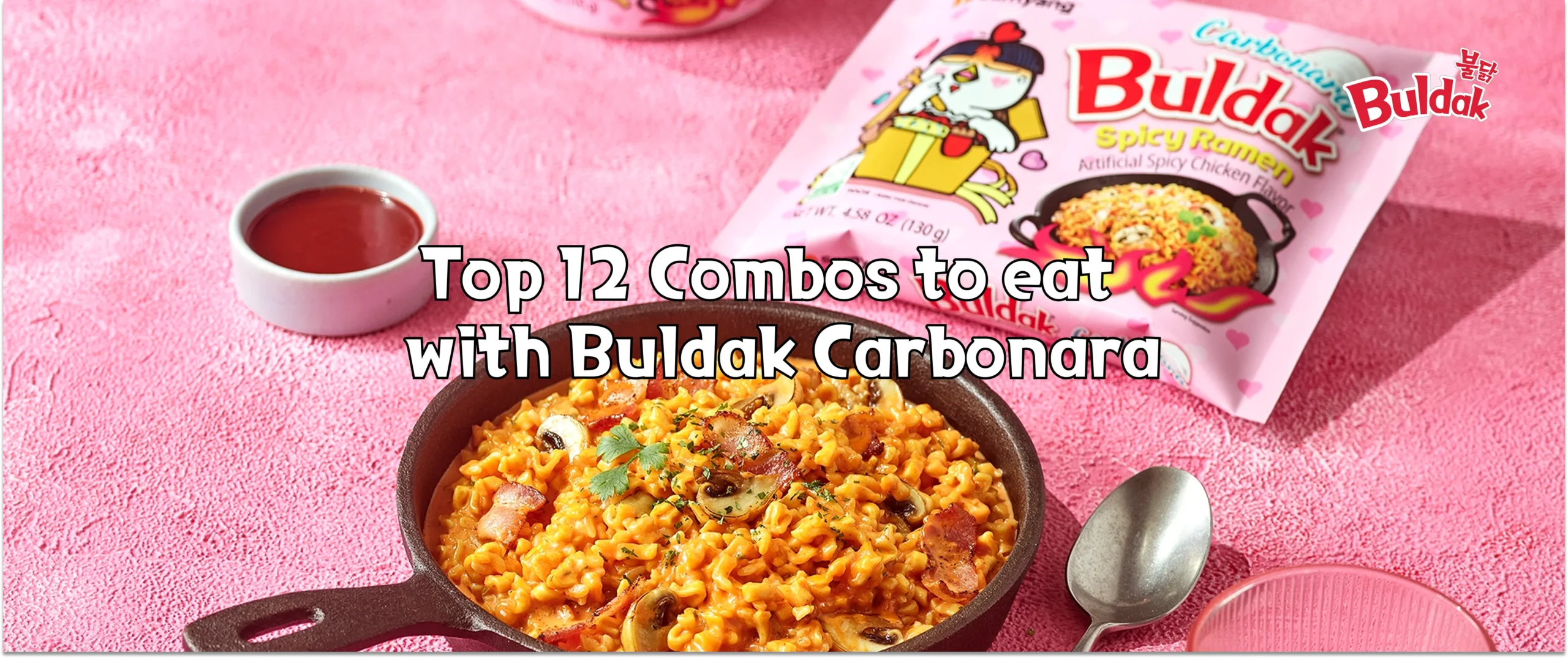Welcome back to the "Korean Spicy Food Hot Spots" series. This is where we explore some of the most famous places in Korea that serve spicy food. If you are a fan of spicy flavors and want to learn more about Korean taste, you are in the right place.
In this episode, we will learn about spicy rice cakes (tteokbokki). This is one of the most popular spicy foods in Korea. We will take a closer look at Sindang-dong Tteokbokki town, a place that many people call a must-visit for lovers of hot and chewy rice cakes.
Of course, not everyone can travel to Seoul to try this food in person. That is why we want to show you Buldak Tteokbokki and Buldak Dumpling. These are great products that bring the flavor of Sindang-dong street food into your own kitchen. If you enjoy spicy food, join us for this delicious journey.
Experience the heat, no passport required →
Bring home the bold taste of Buldak Tteokbokki →
Spicy Food Destination: Sindang-dong Tteokbokki town
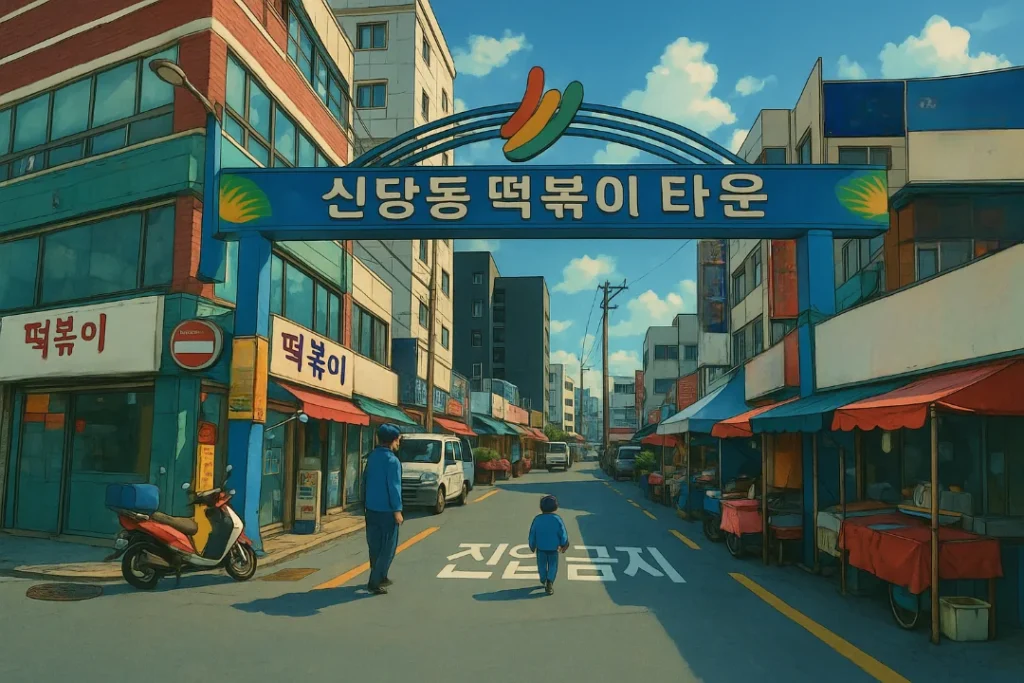
When you think of tteokbokki in Seoul, Tteokbokki Sindang-dong town is the first place that comes to mind. Tucked away in the Jung-gu district, this narrow street is packed with tteokbokki restaurants that have made it a cultural icon. It’s not just a place to grab a bite—it’s a spot filled with memories and emotions for Koreans of all ages.
Even though it is a small town, it is more than just a food street. It is a place full of memories and feelings for many Korean people, from one generation to the next.
What makes this place special is how they serve the food. Tteokbokki is cooked right at the table. Instead of being prepared in the kitchen, chewy rice cakes are brought out with a small gas stove, a pot, and all the ingredients. Diners can cook by themselves or ask the staff to help. This makes the meal more fun and personal.
Besides traditional rice cakes, the shops offer many different toppings. You can add ramen to make it more filling, soft dumplings, fresh fish cakes, or melted cheese for a new kind of taste. Everyone can choose what they like, so every meal feels unique.
One thing that makes Sindang-dong tteokbokki memorable is the sauce. It doesn’t just useKorean chili paste; it also has black bean paste. This makes the taste richer. The sauce is spicy, sweet, and full of flavor. It is something people remember.
But the fun isn’t just about the food. Although most DJ booths are gone now, tteokbokki shops in Sindang-dong used to hire DJs to play music and attract customers. This gave the town a mix of old and new that felt very special.
The history of this town started in 1953, when Ms. Ma Bokrim opened the first shop here. She was the first person to serve tteokbokki cooked at the table. At that time, the Korean War had just ended, and many refugees lived in Sindangdong. She started with a small food cart. Thanks to the special taste and creative service, her shop quickly became popular.
Because Ms. Ma Bokrim’s shop was so popular, many people came and opened their own tteokbokki shops. By 1975, after the river nearby was fixed, there were about 10 shops in the Sindangdong town. From that time, the town became a favorite place for food lovers. In 1993, the shop owners formed a group to protect and grow the area.
In 2013, the Korean government named this town a “Food Theme Street.” This shows it is important to Seoul’s food culture. Many shops here were also added to the “Seoul Future Heritage” list. This list preserves modern places that have cultural value.
When you visit Sindangdong Tteokbokki town today, you will see many shops next to each other. You will hear the sound of cooking, people talking and laughing, and smell the spicy rice cakes. It feels warm and busy. This place is part of many people’s lives. From student dates, friends meeting after school, to late-night dinners. Spicy rice cakes here are not just food, they are part of special memories for many generations.
Complete Guide to Enjoying Sindang-dong Tteokbokki Town
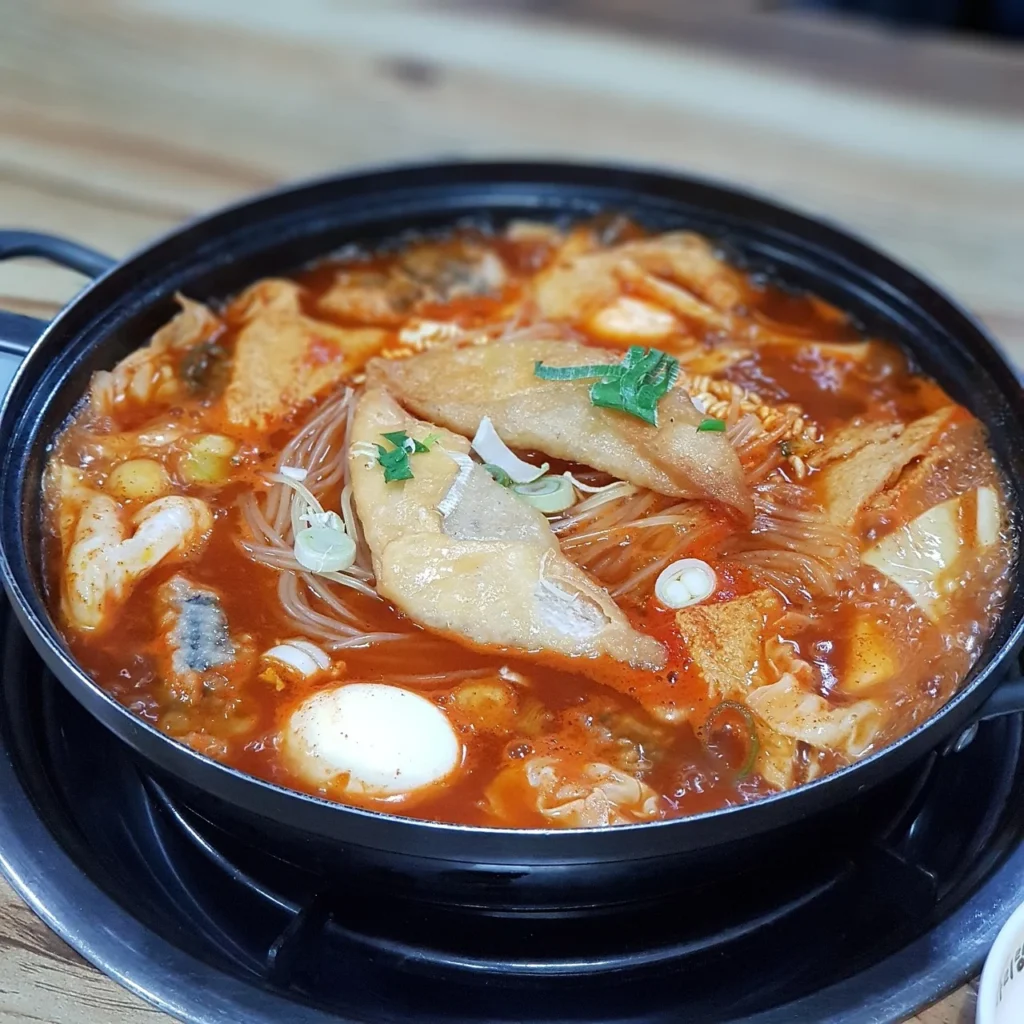
Visiting Sindang-dong tteokbokki town is a fun adventure! Here's how to order and enjoy your meal:
1. Two Kinds of Restaurants
In Sindang-dong, you'll find two types of tteokbokki places. Some shops offer just one kind of tteokbokki. For these, you simply tell them how many people are in your group. Other places have different types, like seafood or cheese tteokbokki. Here, you'll choose your favorite kind and how many servings. Don't worry, it's easy once you know what main ingredients you want!
2. Add Your Favorites
No matter where you go, you can always add more ingredients (called "sari") to your tteokbokki. Feel free to pick what you like to make your dish perfect for you!
3. Eat Noodles Fast!
eat ramen or chewy jjolmyeon noodles quickly once they're cooked. If you wait too long, they'll get soggy and soak up all the delicious tteokbokki sauce.
4. Don't Forget Fried Rice!
You just can't finish your tteokbokki meal without fried rice (bokkeumbap)! It's the best way to end your meal. Make sure to order it after you've eaten most of your tteokbokki.
Types of Tteokbokki: Which One Fits Your Taste?
For many Koreans, tteokbokki is more than just food. It is a special memory that reminds them of school days, time with friends, and street food culture. These memories are tied not only to the taste, but also to the name itself. The word “tteokbokki” comes from two Korean words: “tteok” means rice cake, and “bokki” means stir-fried. Just like the name, the dish is simple, warm, and something people enjoy sharing together.
Traditional tteokbokki is made with rice cakes, gochujang (Korean red pepper paste), fish cake, green onions, and broth. But today, there are many new versions. Each one has different flavors and toppings that match many people's tastes.
1. By Sauce
Tteokbokki is not just spicy. Today, it comes in many kinds of sauces. One of the most common ways to understand this variety is by looking at the sauces. Each sauce gives a new flavor and suits different people.
Original (gochujang)
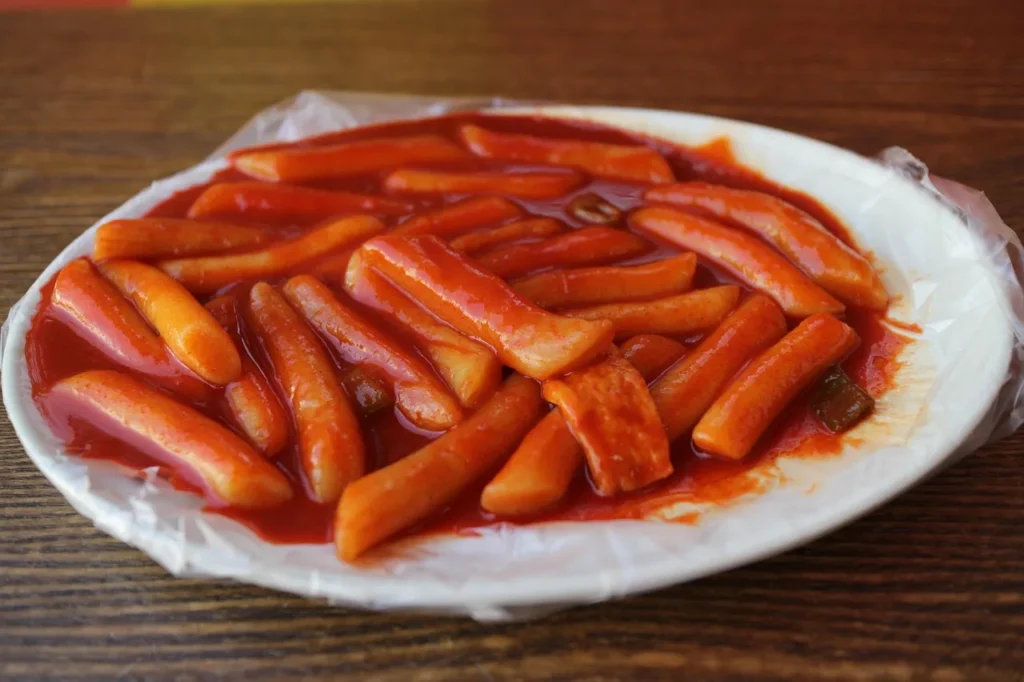
This is the classic type of tteokbokki. It uses gochujang, which is a red pepper paste that brings together sweet, salty, and mild spicy flavors all in one bite. The sauce is thick, rich, and full of flavor. Many people love this version because it keeps the original taste of Korean street food. Even though there are many new styles today, this sauce is still one of the most popular for its deep, balanced, and familiar flavor.
Cheese
This version is for people who love creamy and soft food. When cheese melts over spicy rice cakes, it makes the dish less spicy and very comforting. The thick layer of melted cheese also adds a fun, stretchy texture. It is a top choice among young people, especially the MZ Generation.
Carbonara
This special tteokbokki takes ideas from Italian food. It has a rich, smooth sauce made with cream and cheese, and there's no gochujang in it. When mixed with the chewy rice cakes, you get a really tasty new kind of dish. It's great if you want a mild but satisfying flavor – a yummy change from spicy rice cakes.
Black bean (jjajang)
This is a special mix of rice cakes with jjajang sauce (a black bean paste). The dark color and sweet, bold flavor make this tteokbokki stand out. It is a good choice for people who want a milder and deeper taste compared to the spicy original.
Rose
This is a modern fusion version. It blends traditional gochujang with milk or cream. The result is a light spicy and rich flavor that is smooth and gentle. It is perfect for people who are just starting to try spicy food.
2. By type of rice cake
You might think rice cakes are all the same, but they’re not! Depending on what they’re made from and when they were popular, they can feel and taste totally different. There are two main kinds: wheat-based and rice-based, each with its own texture. The choice depends on what you like and how the tteokbokki restaurant prepares it.
Wheat rice cake (wheat tteok)
Wheat rice cakes came about when rice was hard to get in Korea, especially after the Korean War. The government pushed for wheat flour in cooking, so these rice cakes became a smart, affordable swap.
These rice cakes are soft, wonderfully chewy, and truly soak up sauce like a sponge. As they cook, these wheat flour rice cakes swell up. This action pulls the sauce deep inside the rice cake, making sure every bite is perfectly flavored.
Wheat flour contains special proteins called gliadin and glutenin. When these mix, they create gluten. This is why even when street tteokbokki simmers for a long time, these wheat flour cakes keep their great shape and texture without getting mushy.
Korean rice cake (Rice-based tteok)
As you chew, these rice tteok give off a deeper, nutty flavor. They're also chewier than wheat tteok.
Initially, during the food-scarce 1970s, government efforts to encourage wheat consumption helped popularize tteokbokki made with wheat flour. However, as incomes rose and dietary habits shifted, Korea faced a rice surplus. This led the government to promote the use of rice in products like tteok and makgeolli. As a result, you'll find a higher percentage of rice tteok used today.
Choosing between wheat or rice tteok isn't just about what you like best. It also tells a bit of Korea's history and how society has changed. These small differences make tteokbokki even more interesting and full of stories.
3. By preparation method
Tteokbokki comes in many styles, not only in ingredients and flavor but also in how it is cooked. These different ways of making it show how the dish fits into everyday Korean life. Each method gives a different experience and reflects local food habits.
Cooked at the table (Jeukseok tteokbokki)
This style is popular at places like the ones in Sindangdong. Ingredients such as rice cakes, fish cakes, noodles, cheese and seafood are placed on the table. Diners can cook the dish themselves using a small gas stove, or ask the staff to help. This makes the meal feel more fun, warm and social.
Soup tteokbokki (Gukmul tteokbokki)
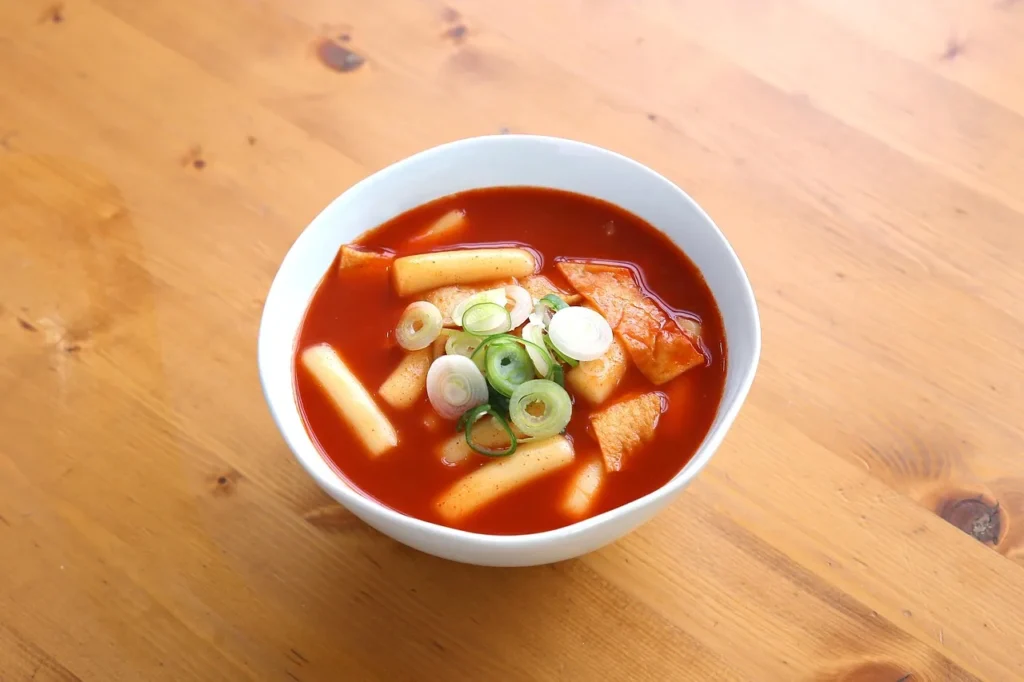
Gukmul tteokbokki is a style of tteokbokki where rice cakes, fish cakes, and various vegetables are cooked in a generous amount of sauce, designed to be enjoyed with a spoon. You'll often find fried dumplings added to soak up the delicious liquid. With its ample sauce, it pairs perfectly with side dishes like fries or Korean rice balls (Jumeokbap).
Market style tteokbokki
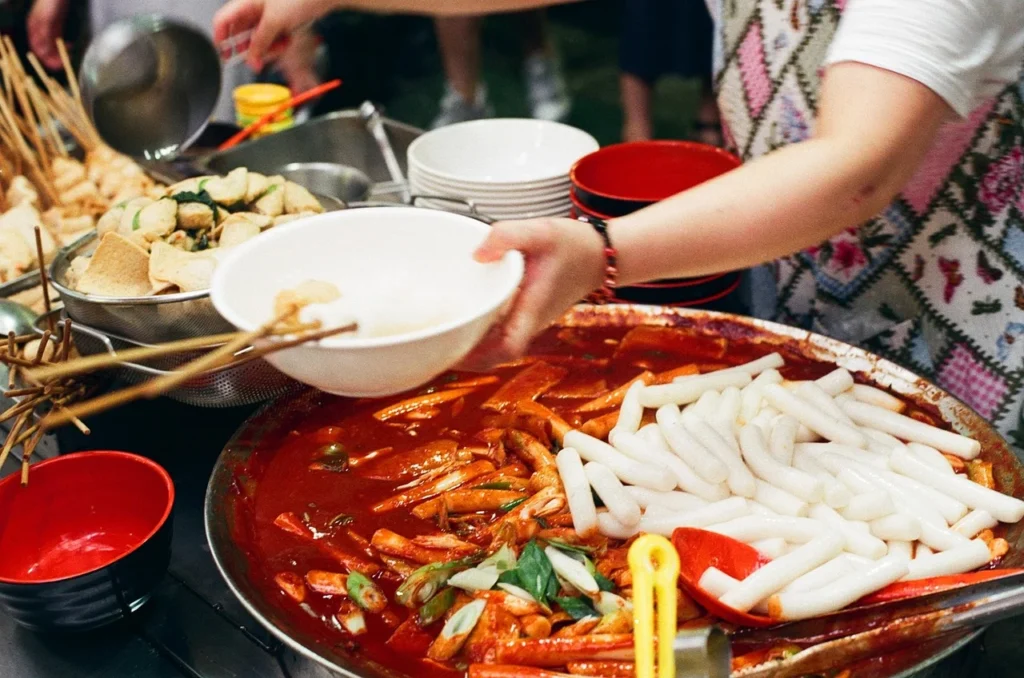
This is a common street food version in Korea. Big pots of tteokbokki are cooked ahead of time and placed at the front of the stall. The rice cakes absorb a lot of sauce and become full of flavor. When someone orders, the seller quickly scoops the food into a bowl. This way of eating is fast, low cost, and very familiar to Korean people—especially students, workers, or anyone who wants something quick and spicy.
Tteokbokki is loved not just for its sweet and spicy taste, but also for its special meaning in Korean life. It started as street food and over time, it became a dish full of memories, feelings, and culture. Today, it is a part of daily life, especially for young people.
For many students in Korea, tteokbokki brings back school memories. After class, friends often meet at snack stalls near school. They enjoy hot, spicy rice cakes and talk about their day. These fun moments stay in their memory for a long time.
Even when people grow up, tteokbokki stays in their lives. After a busy workday, many adults eat it late at night with friends or coworkers. Sitting around a pot of hot rice cakes helps them relax and feel close to others. The food is warm, spicy, and brings comfort after stress.
Tteokbokki also brings families together. It’s common to see grandparents, parents, and children sitting around a pot of tteokbokki. They each take a piece and share stories from their day. Older people may enjoy the classic flavor. Younger ones might like new versions. But everyone enjoys eating together.
Now, spicy rice cakes are not only loved in Korea. They are popular all over the world. Tteokbokki appears on TV, in movies, and on social media. Because of this, more people around the world are learning about Korean food and culture.
Craving Tteokbokki in the US? Try Buldak Tteokbokki as a Spicy Alternative!
Can’t make it to Seoul to slurp up a hot pot of spicy rice cakes in Sindang-dong? No problem! With Buldak Tteokbokki, you can bring that fiery Korean flavor straight to your kitchen. It’s fast, simple, and bursting with that bold K-spice we all love.
All you have to do is open the cup, add a little water, and wait a few minutes. You’ll have soft, chewy tteokbokki soaked in a rich, spicy sauce. It’s easy to make, but the flavor is just satisfying.
So, what makes Buldak Tteokbokki stand out? Let’s take a closer look:
Chewy rice cakes
The rice cakes of Buldak Tteokbokki are not too thick or too thin. They stay chewy and soft even after cooking. Each piece keeps its shape and texture. The outside is just chewy enough, while the inside is soft and smooth. When mixed with the rich, spicy Buldak sauce, every bite is tasty and satisfying.
Unique Spicy Flavor
Buldak sauce is more than just hot. It has a deep, exciting flavor made from gochujang, garlic, onions, and other Korean spices. The heat doesn’t just burn—it brings out real taste. Every bite of rice cake covered in sauce gives you a spicy kick that keeps you coming back for more.
Easy to Make
Whether you’re on a short lunch break or need a late-night snack, Buldak Tteokbokki is ready in minutes. The easiest way is to use a microwave. Just put the rice cakes and sauce in the bowl, add hot water to the line, cover it, and microwave for 2 minutes and 30 seconds. Stir well and eat while it’s still hot.
Perfect for Any Moment
One of the best things about Buldak Tteokbokki is how flexible it is. If you want a quick snack for yourself, one pack of Buldak Tteokbokki is just right. If you’re with friends, you can cook a few packs together. It’s tasty, easy to make, and fun to share. No matter the time or place, it’s always a great choice.
Spicy & chewy — learn more at buldak.com
Spice lovers, your favorite snack is waiting on Amazon
Discover the best ways to enjoy Buldak Tteokbokki. →
Easy Tips to Recreate the “Sindang-dong Style” Experience at Home
Want to make your Buldak Tteokbokki feel like a Sindang-dong feast? Try these fun ideas:
Add different toppings:
To make Buldak Tteokbokki more exciting, try adding toppings like thick ramen noodles, Korean fish cakes, boiled eggs, onions, cheese, vegetables, or slices of sausage. Cheese helps tone down the spiciness and makes the texture smooth and creamy. Boiled eggs cut in half look nice and also add protein. Vegetables bring crunch and color. All of these mix well with rice cakes to make a rich and satisfying pot of tteokbokki.
Use a small pot or cast iron pan to cook at the table:
Set up a small electric stove at your table and invite your friends to cook the dish together. This keeps the food warm and creates a fun, interactive vibe—just like eating tteokbokki at a traditional tteokbokki restaurant. It’s a great way to enjoy a cozy and joyful meal together.
Turn on a fun K-pop playlist and invite friends to cook Buldak Tteokbokki with you:
At Sindang-dong, eating tteokbokki is always full of laughter and energy. You can bring that same feeling into your home.
Where the Tteokbokki Story Lives On
This journey through Sindang-dong Tteokbokki town showed us that it’s more than a food spot—it’s a piece of Korea’s heart, celebrating the love for spicy rice cakes. From Ma Bok-rim’s humble food cart in 1953 to a Seoul icon today, this town has shaped tteokbokki culture for over 70 years.
While nothing beats the experience of walking down the town, hearing the sounds, and smelling the sauce in the air, not everyone can fly to Seoul. Thankfully, the flavor doesn’t have to stay in Korea.
The best part? You don’t need a plane ticket to taste it. Buldak Tteokbokki and Buldak Dumpling bring Sindang-dong to your kitchen, letting you enjoy the flavors of a tteokbokki restaurant at home.
If you ever make it to Korea, swing by the Sindang-dong Tteokbokki Festival in the fall. It’s a blast, with over 10 types of spicy rice cakes to try, live music, and a super fun vibe. It’s a must for anyone exploring Seoul’s food scene. Just remember to check the schedule before your trip—dates may vary from year to year.
Whether you’re savoring Buldak Tteokbokki at home or dreaming of a Sindang-dong trip, you’re now part of the K-spice world. Love spicy rice cakes? Share your story or put Sindang-dong on your foodie list. Keep it spicy and enjoy every bite!
